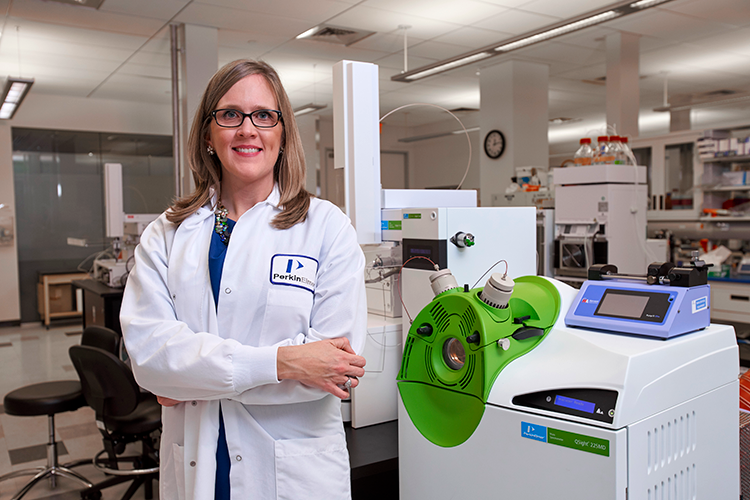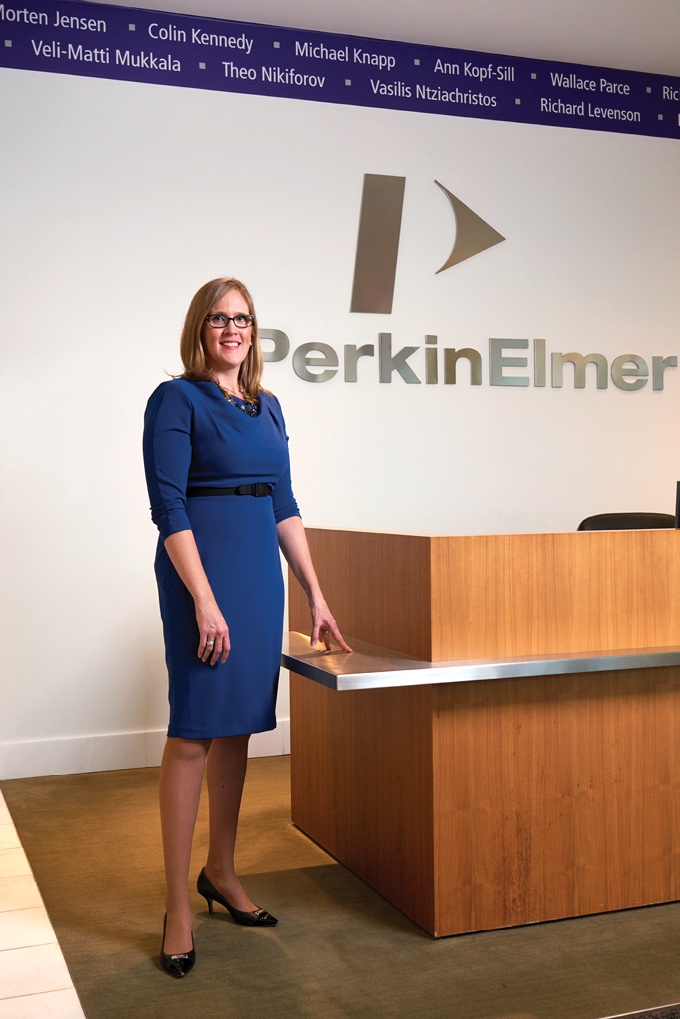
Jennifer Sullivan brings a lifetime of education experience, digital expertise and a willingness to experiment to PerkinElmer.
by Agatha Bordonaro
January 29, 2020
Learning is in Jennifer Sullivan’s blood. The daughter of two longtime educators, she grew up on a boarding school campus in Massachusetts, where her father taught at the high school and her mother at the elementary school. It was perhaps not surprising when she eventually announced that she intended to pursue a career as an elementary education teacher, earning a bachelor’s degree in child development from Vanderbilt University.
“Education was always part of my life — in its entirety,” Sullivan said.
But by the end of her four years at Vanderbilt, she had become more interested in the corporate world and wondered what a career in business might look like for her. A “very astute” professor of hers suggested she audit a few courses in organizational development and leadership to see if the field appealed. Right away she was hooked.

“I felt like I found my calling,” she said.
She was immediately accepted into Vanderbilt’s master’s program in organizational development and leadership, and the rest is history.
“I am a learner and a teacher at heart, but I wanted to do it differently from my parents,” explained Sullivan, who now serves as the chief talent officer for PerkinElmer, a global, $2.8 billion life-sciences firm. Organizational L&D “was this beautiful blend of my interests. From day one of my career, I knew that this was what I wanted to do.”
A Consultative Approach
As head of talent and L&D at PerkinElmer, Sullivan is in charge of ensuring the company’s 12,000 employees are properly trained, engaged, supported and coached, as well as making sure the company recruits and retains the best and brightest individuals. It’s no small job for Sullivan and her team of 10, who are dispersed across the Americas, Asia, Europe and India.
“Jen is a person of vision and she has a very clear, crisp communication style,” said John Luck, vice president for PerkinElmer America’s sales and service division, who served as the executive sponsor of a sales coaching program Sullivan and her team rolled out.
Her vision and communication skills, which contribute to her success in managing such a global team, were likely honed during her past experience as an L&D consultant, Luck said. Sullivan spent about five years consulting for companies like Booz Allen and Vantage Partners before moving internally into leadership development at Raytheon in 2009.
Sullivan credits former colleague and mentor Greg Till, now the executive vice president and chief people officer for Providence St. Joseph Health, with helping her see how she could leverage her prior consulting experience to enhance her learning approach. “He said, ‘You don’t need to know everything. You need to know how to ask powerful, insightful questions and engage the room in answering them.’ And I knew how to do that because I’d been a consultant for years,” Sullivan said. “That became a game changer for me. If you know how to engage people in dialogue and actually make them a part of the solution and honor their expertise, it’s going to be a more impactful learning experience. It will be a better solution.”

Perhaps because learning was infused into every aspect of her life from a young age, Sullivan takes a holistic approach to L&D — it’s tied strategically to the organization’s business goals and seamlessly embedded throughout the employee life cycle.
“Jennifer … comes in and talks to you about the health of your business, and about how learning and development can be a growth engine for the organization,” Luck said. “When you work with Jen, [L&D becomes] this untapped resource that you’ve had the whole time.”
“What makes an exceptional learning organization is recognizing that learning is just a part of the solution, and that you have to look at how learning fits in the entire organizational system to get the results and the outcomes you need,” Sullivan said. “That is what energizes me now: understanding how those pieces work together.”
Innovation Required
When she was looking to hire a new chief learning officer in 2017, Deborah Butters, senior vice president and chief human resources officer for PerkinElmer, knew she needed someone innovative and tech savvy. At the time, at least 90 percent of PerkinElmer’s L&D programs were classroom-based. This meant that the number of employees who could deepen their knowledge and skills and advance in their field was restricted to those who could take time off work and travel to specific locations at specified times; less than 20 percent of the firm’s global population was participating in formal L&D programs. It also meant that creating and rolling out any digital initiatives had to be done mostly from scratch — not to mention thoughtfully, deliberately and with the full support of relevant stakeholders.
“It’s a big change–management effort to go from a largely classroom-based strategy to a largely virtual, tech-enabled strategy,” Sullivan said. “You have to bring the organization along with you, and you also have to look at learner readiness.”
In initial screening interviews, which happened over Skype as Sullivan was based in Seattle at the time, Butters was immediately impressed. “She’s obviously very familiar with research and current thinking around adult learning, but she’s also got a clear view on how technology enables that,” Butters said. “She was able to eloquently talk about what the employee experience is and what we, as a company, were trying to drive toward. Her innovation and passion, her ability to communicate what her vision is and how she approaches it, are probably her top attributes.”

Butters knew she’d found her CLO. In fact, she was so certain that she waited four months for Sullivan to relocate to Waltham, Massachusetts, where PerkinElmer is headquartered.
“I was looking for the right person, and I was willing to wait,” Butters said.
Sullivan joined PerkinElmer in June 2017 and, two years later, was promoted to her current role as chief talent officer, where she now has the added responsibility of overseeing global talent acquisition.
Current Priorities
In the two and a half years that she’s been at PerkinElmer, Sullivan has managed to transform the firm’s L&D into a world-class, technology-forward organization. Again, since most of PerkinElmer’s learning and coaching had been done in classrooms previously, Sullivan knew she couldn’t simply transition employees to a blended platform right away. “I set a big vision for myself and my team to transform the traditional classroom experience into something that’s virtual-scalable, and that has the same kind of features and core characteristics of a classroom environment,” she said.
What did that look like? First, the digital tools had to be accessible anywhere, anytime, and the design had to be flexible. The content also had to be “highly interactive and engaging,” with multiple different ways for users to practice skills, Sullivan said. “Watching a video and reflecting on it wasn’t going to cut it. We had to figure out how they would practice, how they would role-play, how they would wrestle with these ideas,” she said.
The learning also had to fit with the company’s unique culture, so generic or off-the-shelf content probably wouldn’t work. And since the digital nature of the training meant that employees wouldn’t be networking in person, it was also important that the content “facilitate strong community and strong relationship building,” Sullivan said.
To build content that fit these criteria would require thinking outside the box and, perhaps most important, a willingness to try new things. Luckily, Butters said, Sullivan was just the person to do it.
“She’s not afraid to experiment,” Butters said. “That has enabled us to really test out ideas and figure out what works best for our employees.”
“I think an underlying tenet that I’ve given my team is the expectation to try new things, to prototype and to know that it’s safe to fail, frankly,” Sullivan said. “Right now it’s more important for us to try to push the boundaries of how we do learning [and] what technology can do … to drive high-impact learning around this organization. So, we have become very agile in our approach.”
One example of a “highly innovative, scalable, learning-technology-enabled approach” that Sullivan rolled out is MyPath, an entirely virtual L&D pilot program for manager-level employees. Described as a “virtual learning journey with other managers from around the globe,” the pilot, which debuted in 2018, aimed to build managers’ skills in four areas: change management and leadership, coaching and feedback, communication, and data-driven decision-making.
The pilot was an overwhelming success: 87 percent of employees approved of the learning content, with 84 percent saying they would apply what they learned to their jobs.
Other initiatives that Sullivan has successfully rolled out at PerkinElmer include product education for all employees, which she is developing in partnership with relevant business segments, and the Sales Coaching for Performance Program, which Luck sponsored. The program couples sales metrics with coaching content to transform stats from basic yardsticks or even points of contention into catalysts for engagement and problem solving. Sullivan’s ability to see how all the different business areas work together and to gain buy-in was crucial to the success of that program, Luck noted.
“Her ability to communicate and work with all those other functions is really exemplary,” he said.
For her work, Sullivan won a 2014 Gold Award for Best Learning Program Supporting a Change Transformation and a 2019 Silver Award for Excellence in Learning from the Brandon Hall Group.
What Lies Ahead
As Sullivan settles into her new role as head of talent, she is looking at how she can build more intentional bridges between PerkinElmer’s talent acquisition, retention and development goals. “I’m really excited about partnering with the organization to stitch together this end-to-end employee experience,” she said. “[I’d like to] bring together a buy, build and retain strategy against the workforce needs that are out on the horizon.”
Till said Sullivan is uniquely qualified to undertake this challenge. “She is equally skilled in organizational development and design, systems thinking, issue-based conflict resolution, talent management and consulting,” he said. “She also excels at relationship and stakeholder management, ensuring buy-in and support along the way. She is a true business partner.”
Always the educator at heart, Sullivan said the highlight of her days is still witnessing “the light bulb go off” in her team and in the PerkinElmer community. “I’m rarely ever happier than when, on the rare occasion, I get to be back in the classroom and be in front of the room facilitating,” she said. “When you’re teaching a group and you see it happen — I just love being a part of that process.”
Sullivan also plans to continue pushing her team — and organization at large — to innovate new solutions for ever-changing global business challenges.
“I believe it’s our imperative as a learning industry to radically change how we engage with our learners,” she said. “We’ve got to flip learning on its head, where what has been is we take the learner out of their work and bring them to the learning. We have to bring the learning to the learner and integrate it into their day, into their way of working. I fear that if we don’t do that, we’ll be obsolete. We’re at the beginning of a really exciting transformation.”



